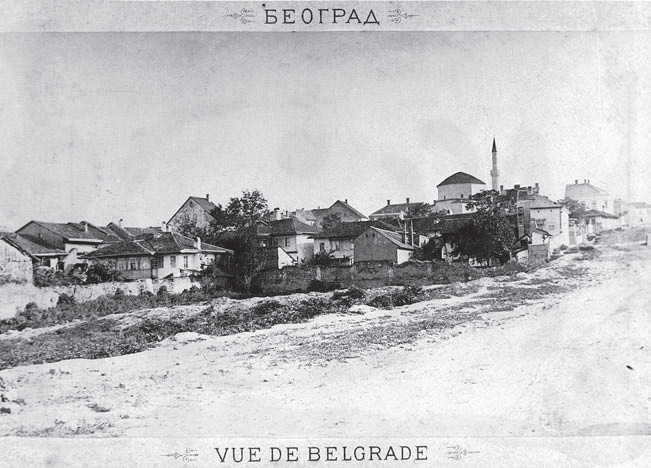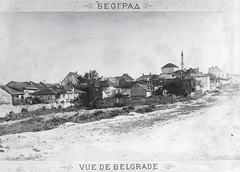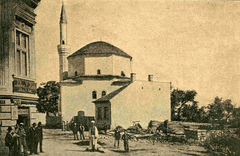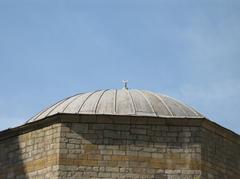
Bajrakli Mosque Visiting Hours, Tickets, and Travel Guide in Belgrade, Serbia
Date: 14/06/2025
Introduction
Nestled in the vibrant Dorćol neighborhood of Belgrade, the Bajrakli Mosque stands as a powerful emblem of the city’s Ottoman legacy and enduring Islamic culture. As the only surviving mosque among over 200 that once graced Belgrade during Ottoman rule, Bajrakli Mosque invites visitors to experience the city’s multicultural past and architectural splendor. Constructed in 1575, its classic single dome, slender minaret, and intricately decorated interiors showcase centuries of artistic and cultural fusion. Today, the mosque remains an active place of worship and a protected cultural monument, welcoming all who wish to explore its history and significance.
This detailed guide provides everything you need for a respectful and enriching visit, including up-to-date Bajrakli Mosque visiting hours, ticket policies, accessibility, architectural highlights, and practical tips. Whether you are a history buff, architecture aficionado, or cultural explorer, this resource ensures your visit to one of Belgrade’s most treasured sites is both rewarding and memorable. For further reading, see sources such as Islamic Arts Magazine, Beotura, and HalalTrip.
Table of Contents
- Introduction
- Historical Overview
- Architectural Highlights
- Cultural and Religious Importance
- Key Historical Events
- Visiting Information
- Visitor Experience and Etiquette
- Frequently Asked Questions (FAQ)
- Conclusion
- References & Further Reading
Historical Overview
Ottoman Origins
Constructed in 1575, Bajrakli Mosque is a rare survivor from Belgrade’s Ottoman era, when the city was home to dozens of mosques and Islamic institutions (Muslim Solo Travel). Its original name, the Cohadzi Mosque, honored Hadzi Alija, a prominent merchant and benefactor. Over time, the mosque came to be known as Bajrakli, derived from the Turkish word “bajrak” (flag), referencing the flag raised on its minaret to signal prayer times (Belgrade Spots).
Endurance Through Upheaval
The mosque has weathered numerous transformations: conversion into a Catholic cathedral during Austrian rule (1717–1739), restoration to Islamic worship under the Ottomans, and several renovations through two world wars and the 2004 unrest (Gradina Zemun). Significant restoration efforts have preserved its original features while reinforcing its status as a protected cultural monument.
Architectural Highlights
Exterior Features
Bajrakli Mosque exemplifies Ottoman religious architecture in the Balkans, with a single prayer hall beneath a central dome and a graceful minaret (Beotura; Wikipedia). Its stone-and-brick façade is characterized by pointed arches and minimal ornamentation, focusing on harmonious proportions over elaborate decoration (Kultur Envanteri). The slender minaret remains a Dorćol landmark.
Interior Features
Inside, the mosque boasts a serene open space beneath the dome, illuminated by arched windows. The finely carved stone mihrab, wooden minbar, and Ottoman calligraphy showcase the artistry of the period. A wooden gallery (mahfil) above the entrance was traditionally reserved for special services. The mosque’s courtyard once included an ablution fountain and a medresa (religious school) with a library.
Cultural and Religious Importance
Spiritual and Social Hub
Bajrakli Mosque serves as the primary center for Islamic worship in Belgrade and a gathering place for the city’s Muslim community (HalalTrip). It is open for all five daily prayers, with Friday (Jum’a) services drawing the largest congregations. The mosque also hosts religious festivals such as Ramadan and Eid, and community events including food distribution and educational programs (HalalTrip).
Symbol of Diversity
Situated near Orthodox churches and the city’s synagogue, Bajrakli Mosque stands as a beacon of religious tolerance and pluralism in Belgrade (GPSmyCity). Its preservation reflects broader efforts to protect cultural heritage and promote interfaith dialogue.
Key Historical Events
- Austrian Occupation (1717–1739): Converted into a Catholic cathedral, while most other mosques in Belgrade were demolished (Gradina Zemun).
- Ottoman Restoration (1741): Returned to Islamic worship, regaining its original character.
- 19th–20th Century Restorations: Renovated under Prince Mihailo Obrenović (1868), with additional repairs after wartime damage and arson in 2004 (Beotura).
- Modern Additions: In 2012, a six-level building was added for religious education and community administration, funded by Azerbaijan.
Visiting Information
Visiting Hours
- General Hours: Open daily to visitors from 9:00 AM to 5:00 PM.
- Worship Access: The mosque remains open to worshippers 24 hours a day.
- Special Considerations: Hours may change during religious holidays or special events. Always check the mosque’s official page or local tourism sources before your visit.
Entry and Tickets
- Entry: Free of charge.
- Donations: Voluntary contributions are welcome to support mosque maintenance.
Accessibility
- The mosque is accessible to visitors with limited mobility, with ramps at the entrance and spacious interiors. Some areas may have steps or uneven surfaces.
Guided Tours
- Availability: Guided tours can be arranged in advance through the mosque administration or local tourist centers.
- Content: Tours offer insights into the mosque’s history, architecture, and cultural significance.
Travel Tips
- Dress modestly: Cover shoulders and knees; women are encouraged to wear a scarf inside the prayer hall.
- Remove shoes: Shoes must be removed before entering the prayer area; racks are provided.
- Photography: Allowed, but always ask for permission, especially during prayers.
- Behavior: Keep noise to a minimum and avoid disruptions during worship.
Nearby Attractions
- Belgrade Fortress and Kalemegdan Park: Major historical and scenic sites within walking distance.
- Knez Mihailova Street: Pedestrian boulevard with shops and cafes.
- National Museum: Offers a broader perspective on Serbian history and culture.
- Dining: Several halal and traditional Serbian restaurants are nearby.
Visitor Experience and Etiquette
Visitors of all backgrounds are welcome, provided they respect the mosque’s sanctity. Modest dress and shoe removal are required. The mosque’s central location in Belgrade’s Old Town makes it an accessible and enriching stop for tourists. Amenities are basic; restrooms are available, but there is no café or gift shop on site.
Frequently Asked Questions (FAQ)
Q: What are the Bajrakli Mosque visiting hours?
A: Generally from 9:00 AM to 5:00 PM for visitors, with the mosque open 24 hours for worshippers. Check ahead for changes during holidays.
Q: Is there an entrance fee?
A: No, entry is free. Donations are appreciated.
Q: Are guided tours available?
A: Yes, arrange in advance through the mosque or local tourism offices.
Q: Can non-Muslims visit the mosque?
A: Yes, outside of main prayer times and with respect for etiquette.
Q: Is the mosque accessible for people with disabilities?
A: Ramps and accessible pathways are provided, though some areas may require assistance.
Q: Is photography permitted?
A: Yes, but always ask permission and avoid disrupting worshippers.
Conclusion
Bajrakli Mosque is not only a remarkable example of Ottoman architecture but also a living symbol of Belgrade’s religious diversity and resilience. Its welcoming atmosphere, free admission, and historical significance make it a must-see for visitors interested in the city’s layered heritage. Plan your visit around prayer times, dress modestly, and take time to appreciate both the mosque and the surrounding Old Town. For the most current information, special event updates, or guided tour bookings, consult official tourism resources or the mosque’s administration.
Ready to explore more of Belgrade’s unique sites? Download the Audiala app for guided tours, updates, and insider tips!
References & Further Reading
- Iran Press
- Gradina Zemun
- Islamic Arts Magazine
- Beotura
- Wikipedia
- Belgrade Spots
- Muslim Solo Travel
- Wanderlog
- HalalTrip
- Lonely Planet
- Balkan Kaleidoscope
- Kultur Envanteri
- GPSmyCity
- Belgrade Beat
- Belgrade Walking Tours










































































